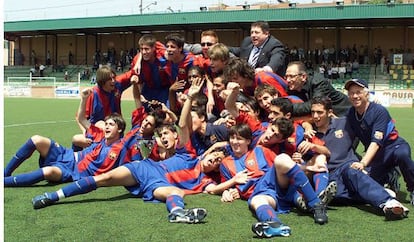The reality behind the dream
Ruling questions Liga clubs' legal right to tie young players down Supreme Court targeting contracts with huge compensation clauses for under-16s

If a child in Spain wants to be a soccer player, there is arguably no better place to learn that at La Masia, FC Barcelona's famed academy. Not only for what it offers as a school and for the very real prospects on going on to make a career out of professional soccer: 23 La Masia graduates have debuted for Barcelona's first team in the past five years. Pepe Reina, Víctor Valdés, Carles Puyol, Gerard Piqué, Xavi, Andrés Iniesta, Cesc Fàbregas and Pedro all went on to win the World Cup with Spain. The majority make their living at other Liga sides or abroad.
But in this paradise that costs the club 15 million euros a year, legal cracks are beginning to show. Last month a Supreme Court ruling in the so-called "Baena case" has thrown into doubt Barcelona's formula for retaining its young stars by considering the contracts it issues abusive. And Fifa has prohibited Barcelona from fielding six junior players for breaking rules concerning the transfer of minors. Both decisions reopen a debate that affects not only Barcelona but all clubs' youth systems (canteras): how to keep the academy tradition alive while protecting the rights of kids that already form part of the huge business that is soccer.
Parents can decide their kid's present, but cannot mortgage their future"
That protection is by no means always guaranteed by parents, distracted by the prospect of their sons setting up the family for life. Although in Spain the minimum working age is 16 and Fifa prohibits under-18s from signing contracts of more than three years and only allows cross-border transfers in exceptional cases, there are many youngsters, some only eight or nine, who catch the attention of scouts. "It's easier to keep the younger kids at the club because their parents tend not to want to uproot," says Pablo Blanco, youth development coach at Sevilla, who played for the club after joining as a youngster. "But from 11 or 12 onwards, all the canteras cherry pick from other youth set-ups."
Clubs invest a great deal of money in youth players and want a return on that investment rather than watching them leave for another club with no more than a "thanks very much" when they are on the verge of the first team. To achieve this, they attempt to tie down players with sophisticated methods. Schooling is paid for, as are accommodation, food and sports gear on top of a monthly allowance, which at Sevilla is up to 400 euros from 14 upwards and at Athletic Bilbao 600 for the best 16-year-olds.
But these amounts are nothing compared to the 4,000 euros the father of a young promise at Málaga receives. "The smaller the club, the more the parents get paid," says an agent who has signed youth players for most of the clubs in La Liga.
The smaller the club, the more the parents get paid," says an agent
In the offices of Camp Nou a perfect formula was discovered more than a decade ago to tie down budding stars that has since been copied at many other clubs. It is the blueprint Barcelona employed with Raúl Baena, who is now 24 and playing for cross-city rival Espanyol.
Baena started out at Faro de Torrox, his village team, and at 11 was scouted by Málaga. Two years later Barcelona showed an interest and his parents did not hesitate. To seal his place at La Masia, on April 22, 2002 the Baena family put pen to paper on three documents. The first was a non-professional contract that guaranteed his board and studies at La Masia, paid trips home and a monthly stipend for expenses. If Baena broke the contract by going to another club, he would have to pay compensation of 30,000 euros.
The second was a "pre-contract" of 10 years' duration that established when and how he would become a professional, at the latest at 18 years of age. It also contained a pay scale through the junior ranks and the ceding of his image rights. The date line on this contract, which carried a compensation clause of three million euros, remained blank as it was to be signed when Baena turned professional. That amount, "agreed freely by both parties," is what Barcelona sought through the courts after Baena signed for Espanyol in 2007.
Rules of the game
- Minimum legal age to work is 16 years old. In exceptional cases can be waived for entertainment purposes but only with prior authorization and if there is no risk to health.
- Fifa establishes that youngsters can only sign contracts after their 16th birthday with parental consent. Up to 18 years, the legal duration is three years. It also bans international transfers of minors unless parents move for work, only within the EU for 16 to 18 year-olds and if club and player are based no more than 50 kilometers from their respective borders.
- Retention rights: Spain allows clubs to tie down 12- to 14-year-olds if a youth team exists (16 to 19 years).
The Supreme Court considered the pre-contract and the sum, which had risen to almost 3.5 million with the Consumer Price Index, null and void as it "violates the superior interest of the minor." Ricardo Morante, Baena's lawyer, said the contract is "completely illegal as it restricts the liberty of a minor to decide his future with a disproportionate clause." And the parents' signatures? "They exceeded their right to representation."
"What the ruling says is that parents can decide over the present of their children, but they cannot mortgage their future," says Antonio Sempere, a Labor Law professor. Essentially, a club and a player's parents can sign what they want but the child is free to make his own decisions from the age of 16. In many cases, these youngsters already have agents anyway.
The battle lost by Barcelona has changed the playing field because most clubs have similar arrangements, agents and lawyers say.
There are no official figures on the extent of the problem, but a few indicators: in the documentation provided by the Professional Football League in various court cases it is stated that between 2004 and 2008 152 contracts of this type were signed, and 114 of them had compensation clauses of three million euros or more, rising to 15 million in some cases. The other 38 contained smaller clauses.
The ruling won't do much; we'll change a couple of things and that will be that"
In the corridors of Fifa there is talk of a European epidemic: in 2011 the world governing body's database recorded 13,000 transfers or inscriptions of players under the age of 18. Of the 1,500 that asked Fifa for authorization, 55 percent of the players were aged between 12 and 15.
It remains unclear, though, what the Supreme Court ruling will actually serve to change on the ground. "It won't do much," says Barcelona's legal department, which after external consultations believes the situation is not greatly worrying. "We'll change a couple of things and it that will be that."
One solution is that clubs and the federation agree on compensation clauses to be paid if one club lures a player from one cantera to another. "The ideal thing would be to have a scale," says Blanco. "Barcelona has a very aggressive policy of recruitment. Every club has, but because of the size of Barcelona and the conditions it offers, it is more attractive."
Many teams insert anti-Real Madrid and Barcelona clauses into youth contracts to keep the big two from pilfering their youngsters. But even Barcelona is not the biggest fish in the European pond. For Camp Nou, the danger comes from the Premier League, which successfully lured Piqué, Fàbregas and Fran Mérida from La Masia for a nominal fee. "It's difficult to compete against 200,000 euros for a four-year contract, despite everything La Masia has to offer," says the club.
Whatever comes from the ruling, the danger exists that clubs will stop investing in young talent. "If huge changes are made, who will want to invest in kids of between 12 and 16?" say many clubs. "The ruling resolved one case but not the overall problem of the canteras, because they invest heavily and want a return," says Sempere. "There needs to be an equilibrium."
Tu suscripción se está usando en otro dispositivo
¿Quieres añadir otro usuario a tu suscripción?
Si continúas leyendo en este dispositivo, no se podrá leer en el otro.
FlechaTu suscripción se está usando en otro dispositivo y solo puedes acceder a EL PAÍS desde un dispositivo a la vez.
Si quieres compartir tu cuenta, cambia tu suscripción a la modalidad Premium, así podrás añadir otro usuario. Cada uno accederá con su propia cuenta de email, lo que os permitirá personalizar vuestra experiencia en EL PAÍS.
En el caso de no saber quién está usando tu cuenta, te recomendamos cambiar tu contraseña aquí.
Si decides continuar compartiendo tu cuenta, este mensaje se mostrará en tu dispositivo y en el de la otra persona que está usando tu cuenta de forma indefinida, afectando a tu experiencia de lectura. Puedes consultar aquí los términos y condiciones de la suscripción digital.







































